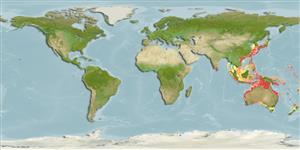Environment: milieu / climate zone / depth range / distribution range
Écologie
marin démersal; non migrateur. Temperate
Western Pacific: Taiwan and Japan to Western Australia and New South Wales.
Taille / Poids / Âge
Maturity: Lm ? range ? - ? cm
Max length : 60.0 cm TL mâle / non sexé; (Ref. 559)
Vomer without a median series of enlarged fangs; caudal fin reduced, tip of tail blunt; anus behind midlength.
Found on the continental shelf, in less than 100 m depth. Poorly known and included in the Muraenesocidae provisionally, pending further study (Ref. 9830).
Life cycle and mating behavior
Maturité | Reproduction | Frai | Œufs | Fécondité | Larves
Paxton, J.R., D.F. Hoese, G.R. Allen and J.E. Hanley, 1989. Pisces. Petromyzontidae to Carangidae. Zoological Catalogue of Australia, Vol. 7. Australian Government Publishing Service, Canberra, 665 p. (Ref. 7300)
Statut dans la liste rouge de l'IUCN (Ref. 130435: Version 2024-2)
Menace pour l'homme
Harmless
Utilisations par l'homme
Pêcheries: sans intérêt
Outils
Articles particuliers
Télécharger en XML
Sources Internet
Estimates based on models
Preferred temperature (Ref.
123201): 19.3 - 28.7, mean 27.2 °C (based on 680 cells).
Phylogenetic diversity index (Ref.
82804): PD
50 = 1.0000 [Uniqueness, from 0.5 = low to 2.0 = high].
Bayesian length-weight: a=0.00155 (0.00068 - 0.00355), b=2.92 (2.72 - 3.12), in cm total length, based on LWR estimates for this (Sub)family-body shape (Ref.
93245).
Niveau trophique (Ref.
69278): 3.8 ±0.6 se; based on size and trophs of closest relatives
Résilience (Ref.
120179): Milieu, temps minimum de doublement de population : 1,4 à 4,4 années (Preliminary K or Fecundity.).
Fishing Vulnerability (Ref.
59153): Moderate vulnerability (44 of 100).
Nutrients (Ref.
124155): Calcium = 30.7 [19.3, 54.0] mg/100g; Iron = 0.323 [0.194, 0.524] mg/100g; Protein = 18 [16, 20] %; Omega3 = 0.595 [0.285, 1.517] g/100g; Selenium = 21.9 [12.1, 40.4] μg/100g; VitaminA = 12.6 [3.4, 44.4] μg/100g; Zinc = 0.471 [0.349, 0.656] mg/100g (wet weight);
